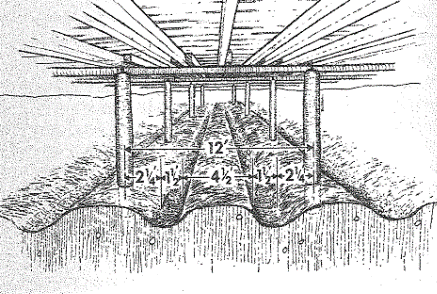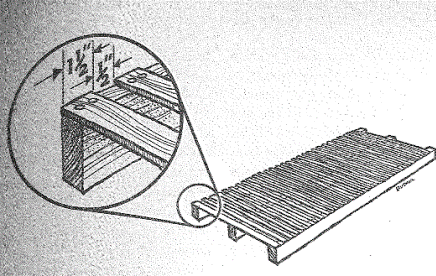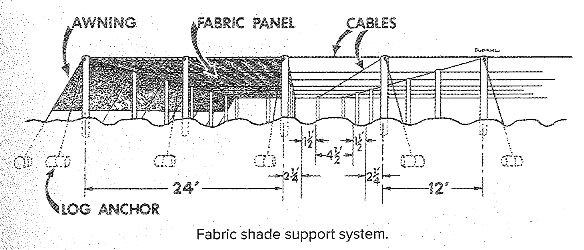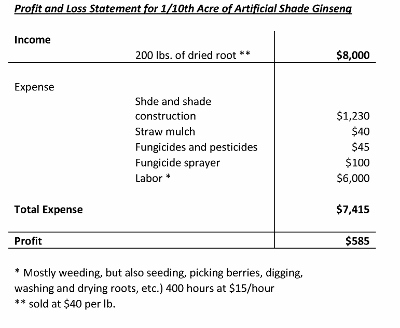Select a planting site on gently sloping land (about 6-10 percent slope). The area should be able to support the shade structure and also promote drainage.
PREPARING THE BED:Usually, ginseng is planted in the fall. To reduce future weed problems, till the field in advance. Prior to planting, stake out the shade structure dimensions, set the posts that will support the artificial shade, and break up the soil to make the planting beds. The planting beds are usually 4'-6' wide, slightly raised with ditches that run directly down the face of the slope (ideally 6 degrees) so that heavy rainfall will run off quicker.
FERTILIZING:Ginseng grows better in soil that is high in organic matter. Consider having your soil tested. Calcium levels should be at least 2000 pounds per acre with low nitrogen levels. Some growers mix in some humus-rich soil from the forest to their planting beds. Tilling in 2-3 inches of shredded, partially decayed hardwood leaves and bark will add organic matter to your soil.
PLANTING:If you plan to harvest within 3-4 years, sowing about 20 seeds per square foot is typical, that's about 90-100 pounds of seed per acre. But if you plan to harvest your ginseng after 4 years plus, sowing about 8-10 seeds per square foot would be appropriate. Ginseng seeds should ideally be planted about 1/2" to 3/4" deep, but no greater than 1" deep. If you cast your seeds by hand, rake a thin layer of soil over the seeds to ensure good soil contact and to protect them from drying out.
To prevent overcrowding, transplanting might be necessary to produce better quality roots. If you plan to harvest in 4-8 years, space them about 6" apart. If your plan is to grow ginseng plants for long-term seed production, then space them about 9" - 12" apart so each ginseng plant has enough room to grow.
MULCHING:Mulch right after fall planting. Mulching serves many purposes. Mulch prevents growth of weeds and prevents frost heaving in the winter. Use of seed-free mulch is best because it reduces potential weed and rodent problems. Most ginseng shade farmers choose to mulch with straw. Oat straw is a better choice because it has been rethreshed to rid of any remaining grain and weed seeds, but keep in mind that straw decomposes quickly making slugs a bothersome pest.
SHADE STRUCTURE:The sun passes over from east to west so the strips of shade must run north-south to shade the ginseng plants properly. Selecting the type of shade structure to construct will differ in the amount of light penetration and air flow. There are 2 types of shade structures, wood lath and cloth shade.
- WOOD LATH SHADE:
Construction of wood lath shade is a lot of work and can be costly. Because of this, this method is becoming less used. Cedar or locust posts that are 8' to 9' in length and 6" in diameter are often used. This will provide a working space height of over 6' as well as provide enough ventilation room for air to circulate. A 12 'x 12' grid pattern example will be described but variations can be made to suit your needs and space. Set the posts about 2' into the ground and 12' apart from the center of every other 4 1/2' wide planting bed. Make drainage trenches 1 1/2' wide on either side of each planting bed. Connect 12' long 2 x 4's to the tops of the posts to support lath shade sections. Each lath shade section is 4'x 12' using three 12' runners spaced out evenly. Nail or staple 1 1/2" hemlock or cedar lath strips across the runners with 1/2" space between each lath strip. This will provide about 75% - 80% shade. It is very important that the laths run north-south to the sun's east to west movement. Place the lath strips into position on the posts before the ginseng plants sprout in the spring. Remember to walk in the drainage trenches, not the planting beds. During the winter of northern climates, take down lath sections or double stack them to avoid risking damage from heavy snow loads. A snow fence surrounding the outside edges will provide shade to the outer edge ginseng plants as well as keep the critters away. Another option would be to extend the overhead shade structure by several feet beyond the planted area (especially on the south and west sides) and leave the sides open to improve air circulation.

Spacing of beds, drainage trenches, and posts

Wood lath Section
- CLOTH SHADE: Black polypropylene cloth is a popular choice to use because the polypropylene strands are infused with nickel and carbon black to block out the sun's UV rays. Do not use solid mesh, instead, use a thick and thin pattern to mimick the shading effects of lath strips and also to provide better air circulation. Run the striped pattern north to south. It is very important to follow installation instructions from the start. The cloth comes in long strips, up to 24' wide. Set posts in a 24' x 24' grid pattern. Center the post in every fourth planting bed. Stretch a 1/4" cable between the post tops in a grid pattern and fasten to anchors on the ground around the perimeter of the ginseng planting area. Unroll the 24' wide shade strips on top of the grid and attach to the cable using S-hooks. A snow fence around the perimeter provides shade along the edges of the planting beds (especially on the south and west sides) or attach a 5' wide shade cloth awning along the ground support cables at a 45 degree angle from the top of the outside cable for shade along the planting edge. Keeping the sides open by extending the overhead cloth beyond the planting edge so that the beds are shaded can also be done and this will improve air circulation as well. The shade material must be removed before winter to prevent damage from snow.

ADVANTAGES of ARTIFICIAL SHADE GINSENG FARMING
- growing ginseng roots quicker so that roots can be potentially ready to harvest in 3-4 years
- less complicated planting bed preparation because you wouldn't have to deal with tree roots or rocks like in woods cultivation
- with snow fences or shade awnings in place, critters are less likely to get at your ginseng plants or berries
- it's easier to dig the ginseng roots in an open field with planting beds that are straight and level. Remember to take down or furl the shade structure prior to digging
- the shade structure can be re-used for multiple seasons with proper maintenance saving on annual costs
DISADVANTAGES of ARTIFICIAL SHADE GINSENG FARMING
- cost of shade, either wood lath or cloth, can be expensive
- time and effort needed to put up the shade structure and maintain it can be labor and cost intensive
- weeds can be a big problem. They compete ginseng for nutrients and can reduce air circulation, thereby creating a humid environment where disease can easily spread. Farmers have used chemicals, fungicides, pesticides and herbicides but you MUST check with federal and state regulations on approved use of such products on ginseng plants
- spread of disease in an environment with poor air circulation and dense planting
EXAMPLE OF ARTIFICIAL SHADE FARMING COSTS
The following table is a rough example of the costs associated with growing ginseng under artificial shade for one-tenth of an acre. Costs of the land and the seeds as well as the energy bill for drying the roots are not included.


